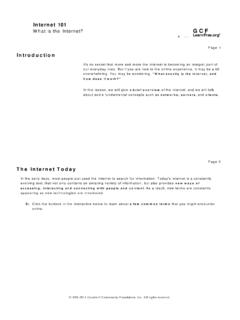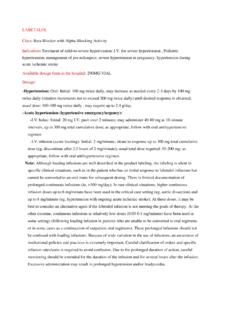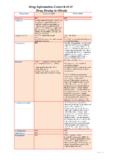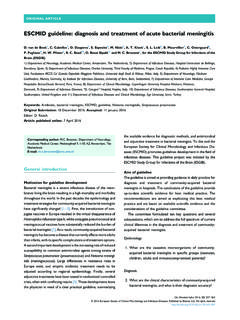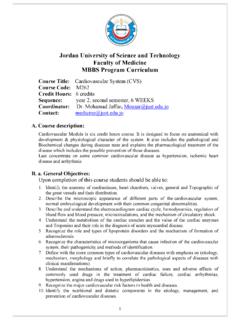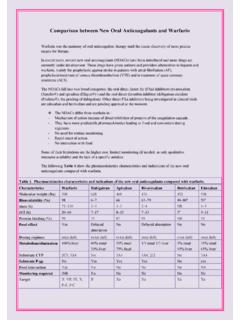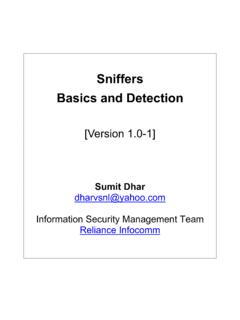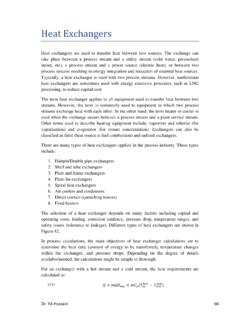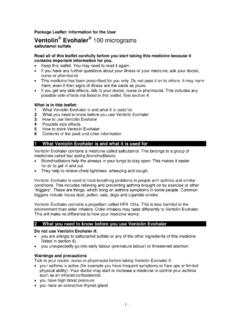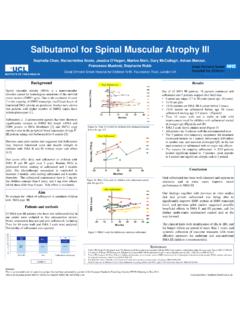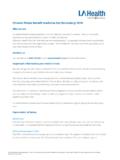Transcription of Guidelines for the Emergency Treatment of …
1 Page 1 of 2 Guidelines for the Emergency Treatment of hyperkalaemia Check K+ (Venous Blood Gas & Laboratory sample). *See associated supplementary information sheet overleaf (including advice on drug administration). # CBG = Capillary blood glucose Perform 12 lead ECG. Are ECG changes present? Give 30mls of 10% calcium gluconate IV over 5-10 minutes. Repeat at 5 minutes if persistent ECG changes* Give 10 units of Actrapid in 50mls of 50% dextrose IV over 15 minutes and measure CBG# at 0, 15 and 30 minutes after starting Treatment .
2 Then hourly, up to six hours after Treatment * And give nebulised salbutamol 10mg to 20mg, as tolerated. Give 10mg salbutamol if ischaemic heart disease or tachycardia* Stop potassium retaining drugs* Refer to dietitians for low-potassium diet and monitor serum potassium* Mild (K+ = ) Moderate (K+ = ) Severe (K+ ) YES NO Monitor serum potassium and blood glucose* Discuss all unstable patients or those with multi-organ failure, with severe hyperkalaemia with DCC first. If stable, discuss all patients with severe hyperkalaemia or AKI/Oligo-anuria with renal SpR or consultant on-call and refer to AKI bundle. Discuss all dialysis or renal transplant patients with renal SpR or renal consultant on-call. Authors: Dr Tom Pickett & Israr Baig Approved by: Drug & Therapeutics Committee February 2016 Review date.
3 February 2018 Page 2 of 2 Treatment Start with assessment of the patient (ABCDE) and the risk of arrhythmia, including potential rate of rise in serum potassium ( rhabdomyolysis or other tissue necrosis or oliguric renal failure).
4 Perform 12 lead ECG if Serum K+ Protect Cardiac Membrane If required, administer 30ml calcium gluconate 10% neat over 5 minutes via large peripheral vein, with continuous cardiac monitoring. If large vein is not available, administer over 10 minutes and watch for extravasation. Repeat dose after 5 minutes if ECG changes persist; can be repeated every five minutes. Effects are transient (30-60 minutes). Administer over 30 minutes if patient taking digoxin Do not administer sodium bicarbonate simultaneously via same access (risk of formation of insoluble calcium salts) or mix with any other drugs (risk of incompatibility). Shift potassium into cells Insulin Actrapid + dextrose Administer 10 units of insulin Actrapid in 50ml of 50% dextrose.
5 Effects peak at 30-60 min & last for up to 6 hours. Do not give dextrose in DKA, give insulin only if CBG is 20. Nebulised Salbutamol Administer 10mg-20mg nebulised salbutamol (10mg in patients with IHD, severe tachycardia). In combination with insulin/dextrose, salbutamol can lower serum potassium by an additional Effect lasts up to 2 hours. Nebulised salbutamol may not be effective, especially in those patients taking beta-blockers or digoxin, but may be used as first-line Treatment whilst IV access is being established. Sodium bicarbonate Can shift potassium from the extracellular to intracellular by increasing blood pH. The evidence for routine use in hyperkalaemia is controversial, its effects are of variable onset and not sustained.
6 Its use should be limited to cases of severe metabolic acidosis when recommended by an Intensivist or Nephrologist. Remove potassium from body Do not use cation-exchange resins (Calcium Resonium / Resonium A ) for the Emergency Treatment of severe hyperkalaemia . The onset of action is slow (up to five days) and they can cause severe gastrointestinal side-effects. Haemodialysis or haemofiltration are the most effective but invasive treatments for severe resistant hyperkalaemia where other measures have been unsuccessful or if there is ongoing tissue damage. Critical Care or the on-call Renal Consultant should be consulted early in these circumstances. Prevent recurrence Stop offending medications, it may not be appropriate to stop all.
7 Those most commonly implicated are as follows: Potassium supplements, salt substitutes ( LoSalt), ACE-I, Angiotensin II Receptor Blockers, NSAIDs,spironolactone, eplerenone, amiloride, trimethoprim, digoxin. Once urgent Treatment has been instigated ensure patient is placed on a low potassium diet. It is reasonable to refer patients with CKD stage 4 and 5 to dietician prior to discharge. Monitoring ECG: Repeat 12 lead ECG should always be performed after administration of calcium gluconate to confirm resolution of ECG changes. Typical ECG changes include peaked T waves, prolonged PR interval, absent or flattened P waves, bradycardia, broad QRS, VT, sine wave morphology. Ongoing ECG monitoring is available on ACU and the Stroke wards as well as Cardiology and Critical Care Units.
8 Do not delay Emergency Treatment while awaiting patient transfer. Potassium: measure potassium at 1, 2, 4, 6 hours after initial Treatment to determine if potassium serum has decreased sufficiently and to detect any rebound. Measure potassium at 24 hours to ensure that this has been maintained. Aim to achieve serum potassium < mmol/L within 2 hours Glucose: Delayed hypoglycaemia is commonly reported with insulin/dextrose management. Monitor capillary glucose at 0, 15, 30 minutes after starting Treatment and then hourly up to 6 hours.
